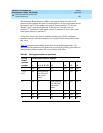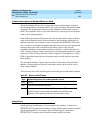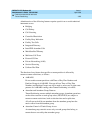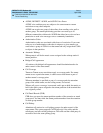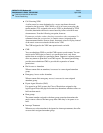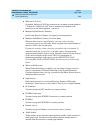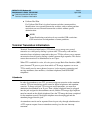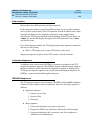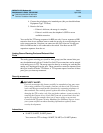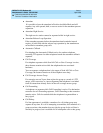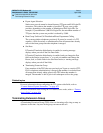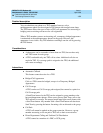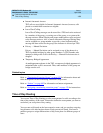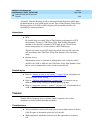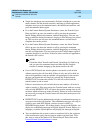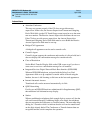
DEFINITY ECS Release 8.2
Administrator’s Guide
555-233-506
Issue 1
April 2000
Features and technical reference
1549Terminal Translation Initialization
20
4. Connect the telephone to its intended port (this port should indicate
Equipment Type: TTI Port).
5. Receive dial tone.
— If there is dial tone, the merge is complete.
— If there is no dial tone, the telephone’s SPID is not an
available extension.
You can dial the TTI merge sequence for BRI sets only if a user separates a BRI
extension from its set and then wants to undo the process by reassociating the set
to the same extension. Note that you cannot use the SAT to put an X in the port
field of a BRI set that is still connected to the switch. You must use the TTI
separation sequence from the set.
Analog Queue Warning Ports and External Alert
Ports
The analog queue warning port (used for hunt groups) and the external alert port
may be administered with an X in the Port field. These extensions can be merged
to an analog port via TTI. The merge must be done by an analog set, and then the
analog set is unplugged from the port. These extensions cannot be separated from
their port location with the TTI feature. A TTI separate request from one of these
ports gives you intercept treatment.
Security measures
!
SECURITY ALERT:
If you do not manage this feature carefully, its unauthorized use may cause
you security problems. For example, someone who knows the TTI security
code could disrupt normal business functions by separating telephones or
data terminals. You can help protect against this action by frequently
changing the TTI security code. You can further enhance system security by
removing the Feature Access Code (FAC) from the system when it does not
need to be used (for example, there are no moves going on at present).
Consult the BCS Systems Security Handbook for additional steps to secure
your system and find out about obtaining information regularly about
security developments.
Interactions
■ 10-MET, 20-MET, 30-MET phones
You cannot use TTI to change 10-MET, 20-MET, or 30-MET phones.



